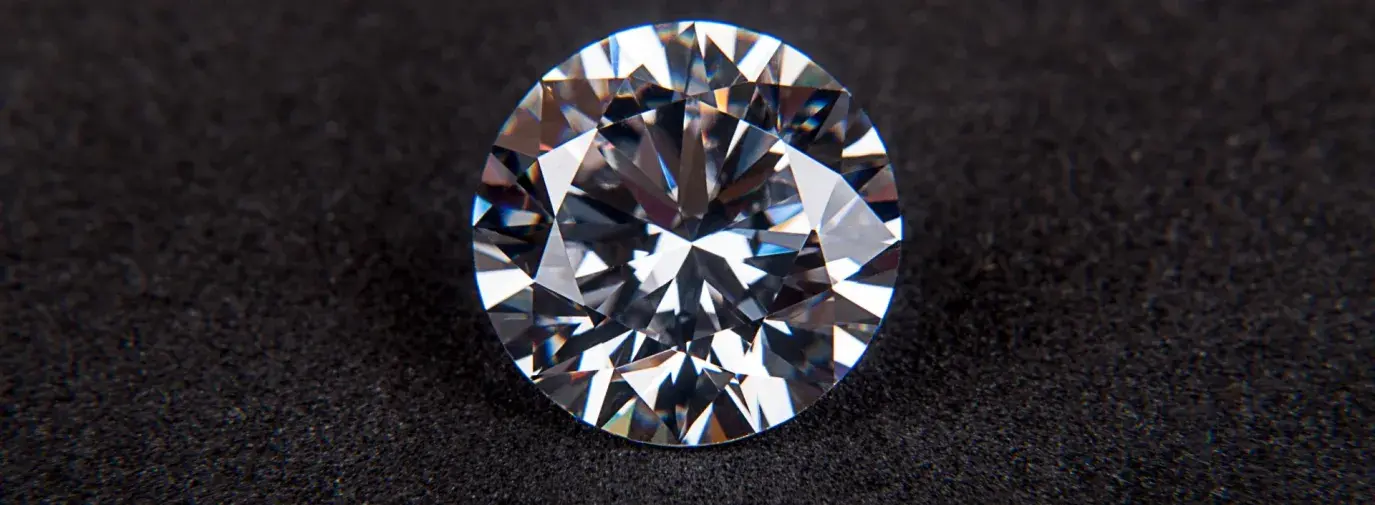
Diamonds, rubies, and other gems have long been prized for the beauty they bring to engagement rings and other fine jewelry-but in recent years, more and more people have become aware of the ugly story behind some of the world's most precious stones. Read on to learn more about the concerns associated with precious gems, and what you can do to support ethical jewelry, reducing gems' cost to workers, communities, and the Earth.
Worker and Community Hazards
Gemstone mining can be hazardous to the health of workers and communities alike. Diamond miners often work in cramped and unsafe conditions in tunnels, and dust from the mines can cause respiratory diseases in workers and residents of nearby communities. Mining of colored gemstones, such as rubies and emeralds, is generally done on a smaller scale than diamond mining, but still holds risks. According to the International Labour Organization (ILO), many small-scale miners are unable to invest in the tools and equipment that could prevent accidents. Because mining involves moving large amounts of earth, it can also alter local ecosystems and damage watersheds. And, although many of the countries where gems are mined have laws setting a minimum age for workers in hazardous occupations, the ILO has also documented child labor in mines.
Child labor is also a problem in the cutting and polishing phase of both diamond and colored gemstone production, much of which takes place Asia; according to the ILO, India alone polishes 70 percent (by weight) of the global diamonds yield. In her book Glitter & Greed: The Secret World of the Diamond Empire (The Disinformation Company, 2003), Janine Roberts explains, "Child labor is illegal in India, but this law is much ignored. Sharp young eyes are much prized by Indian diamond traders."
The human suffering linked to gem production doesn't end with those who mine and cut the stones. In Angola, the Democratic Republic of Congo, Liberia, and Sierra Leone, profits from diamond sales have funded weapons purchases for armed opposition groups such as Sierra Leone's Revolutionary United Front, which perpetrate human rights abuses.
Conflict Diamonds
The nonprofit human rights group Global Witness first brought international attention to the issue of 'conflict diamonds' fueling and prolonging violent conflicts in 1998. Along with Physicians for Human Rights and other groups, they raised consumer awareness of diamonds' link to war and called on diamond dealers to stop buying stones from countries where diamond sales are used to fund armed conflicts. The United Nations Security Council officially recognized the role of conflict diamonds in prolonging violent conflicts in some countries, and then urged the diamond industry to develop a global tracking system that would confirm the origins of uncut stones and establish a paper trail of ownership.
Michael Fleshman, writing in the UN magazine Africa Recovery in 2001, credits NGO campaigns with making the diamond industry more receptive to the UN's call for a global tracking system than it otherwise would have been.
Members of the diamond industry began meeting about the issue in 1999, and in 2002, the industry launched the Kimberley Process Certification Scheme. The Kimberley Process, which entered into force in January of 2003, requires countries exporting rough diamonds to ship them in tamper-proof containers along with certificates guaranteeing the packages' origins and contents. Countries receiving the shipments must certify that they have not been tampered with. Only countries that belong to the Kimberley Process can legally trade in rough diamonds.
Several human rights groups have acknowledged the Kimberley Process as a step in the right direction while criticizing its lack of independent monitoring and verification. Groups such as Global Witness and Amnesty International continue to press the diamond industry to add auditing, verification, and oversight components to the Kimberley Process. Other advocacy groups are drawing attention to the way people, many of them indigenous groups who've lived on the same land for centuries, can face eviction when gem deposits are discovered in their areas.
Ethical Jewelry is Changing the Gem Industry
According to Brian Leber, president of Leber Jeweler Inc, "The diamond industry tried to stonewall when the 'conflict diamond' story first broke, but they responded once the public pressure got strong enough." Now, Leber and Eric Braunwart, president of Columbia Gem House, Inc./Tri-Gem Designs, are working to get the colored gem industry to join the diamond industry in moving toward fair, sustainable practices and produce ethical jewelry.
Before the US banned imports from Burma in 2003, Leber urged the colored gem industry to stop buying Burmese rubies, which were funding the abusive military junta in power there. According to Professional Jeweler magazine, major retailer Tiffany & Co. will begin purchasing Burmese rubies again, since rubies mined in Burma but cut elsewhere are exempt from the import restrictions. Leber says his company will continue to refuse to sell Burmese rubies, and will instead support the Jewelers' Burma Relief Project, founded by Leber in 2004, which works with the Foundation for the People of Burma to provide direct medical, educational, and micro-business development assistance to the Burmese.
Braunwart, meanwhile, has developed a system that applies fair trade principles to the production of colored gemstones. Columbia Gem House's extensive protocols include "environmental protection, fair labor practices at the cutting and jewelry factories, and a tight chain of custody," Braunwart explains. As an example, he describes Columbia's relationship with the Chimwadzulu Mine in Malawi, where rare Nyala ruby is found: the company pays above-minimum wage and offers health benefits to workers, and it has built a school for the workers' children. Uncut stones go directly from this mine to Columbia's Chinese cutting factory, where workers are paid three times the minimum wage and receive benefits that include room and board, food allowances, paid vacation, and medical and disability insurance.
"This isn't just good for the workers," says Braunwart. "It's good for business, too, because satisfied workers put more effort into improving the quality of the product. Turnover is low, so workers become very experienced and skilled. As a result, the quality of our products rivals any in the world." Gem retailers and jewelry purchasers will pay more for high-quality products, and it seems they'll also seek out gems that are more socially responsible than standard offerings: Braunwart says that Columbia Gem House's sales have surged 20-30 percent annually since he introduced his Fair Trade Gems Initiative in 2001.
Some of Columbia's gems are turned into jewelry at its Tri-Gem Design subsidiary, while others are sold to jewelry retailers such as Leber Jeweler Inc. and Sumiche Jewelry Co.. "Ideally, we'd be able to deal directly with the people who mined the stones, so we could be sure that they were being produced under fair conditions, but for a business as small as ours, it just isn't feasible," says Sumiche president Miché Onaclea. "I need to find suppliers I can trust to perform the oversight, like Columbia Gem House."
Onaclea notes that customers have responded well to her company's responsible gems. "Some people had been avoiding buying gems because they'd learned about the conditions some of them were produced under, so they were glad when we started offering alternatives."
As the current president of the American Gem Trade Association (AGTA), Braunwart has convinced the organization's board to consider ways to adapt AGTA’s code of conduct to include "best practices" for gem sourcing. "The industry is slowly becoming more aware of the issues around where our gems come from," he says-and notes that at February’s AGTA conference, three presentations were on issues related to fair trade, making it "the buzz of the show."
What You Can Do To Support Ethical Jewelry
You can help improve conditions for miners, cutters, and communities around the world:
- Seek out responsible alternatives: Buy ethical jewelry from companies that have taken steps to ensure that their gems were produced responsibly. Green America’s National Green Pages™ lists several such companies, including some that get their products directly from fair trade cooperatives. Some also offer jewelry made from recycled or responsibly mined metals. (See "Gold Loses Some Glitter," Real Money Jan/Feb 2005, to learn about concerns around gold.) Or, get your jewelry secondhand.
- Ask questions: "Consumers play the critical part," says Braunwart. "Most businesses won't change their policies because it’s the right thing to do; they’ll change once they see there's a demand for more responsible products." Let jewelry retailers know that you're concerned about issues surrounding gemstone production and ask what they are doing to address such concerns. Also ask where stones came from and what kind of documentation they have to trace them. The trade association Jewelers of America has developed a "Social, Ethical, and Environmental Statement of Principles" that its members can use to guide their business practices. If your jewelry retailer is a member, you can ask whether it has adopted these principles. Also, Leber cautions consumers not to assume that synthetic gems are necessarily more responsible-these gems, like real ones, may be cut under unhealthy conditions by workers paid starvation wages. Ask where and under what conditions synthetic gems were cut.
- Support campaigns: Learn more about the issue of conflict diamonds and support human rights groups such as Amnesty International and Global Witness that are pressuring the diamond industry to make the Kimberley Process an effective tool.
- Spread the word to your friends and family. Together, we can make the production of gemstones safer and more ethical for all involved.







